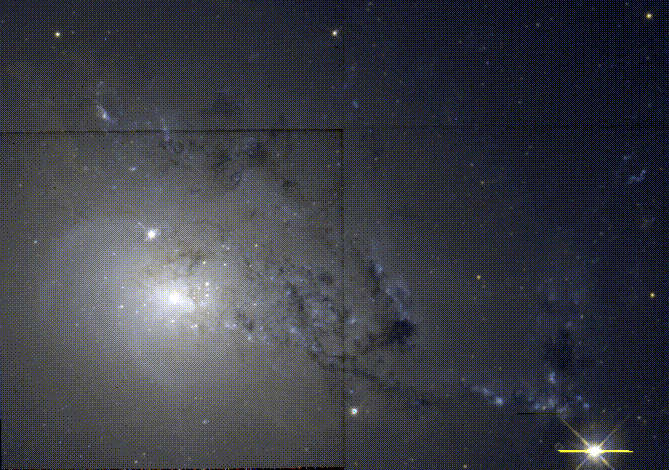
What's going on here? In fact, how many different things are going on here? NGC 1275 has been called, at various times and not always by different astronomers, a Seyfert galaxy, radio galaxy, and even blazar... Carl Seyfert listed it in his 1943 paper on the galaxies now bearing his name, and NGC 1275 has long been an oddball among bright Seyferts - whatever the host galaxy is, it is distinctly not a spiral. It is a strong radio source (3C 84), and shows variability that has occasionally been attributed to seeing a BL Lacertae-like object "off the beam". Adding to the confusion, there is clearly something rich in gas and dust in front of NGC 1275, though the interloper's redshift is 3000 km/s higher than that of NGC 1275 itself. It shows up as a network of dusty patches with some associated blue star clusters in this view, and can also be detected absorbing radio emission at certain frequencies from the nucleus itself (it is the absorption which guarantees it to be in front of NGC 125 and its active nucleus). In the rich environment of the Perseus cluster of galaxies (Abell 426, which is more or less centered on NGC 1275) such high velocities might rarely occur as galaxies mill around in their mutual gravity, but the foreground object looks, if anything, like a skeletal view of a spiral or irregular galaxy, which are virtually absent in the Perseus cluster. Despite the fact that it hasn't yet actually hit NGC 1275, could this mystery object be related to the nuclear fireworks? And the cluster itself - does being centered in the slowly cooling and shrinking central flow of hot X-ray gas have anything to do with fuelling the monster in NGC 1275?
This is an excellent example of a galaxy rich in young blue star clusters - so bright that they have been termed super star clusters. Such clusters are often linked to galaxy collisions and mergers, an interpretation strengthened in this case by the ripples superimposed on the smooth stellar distribution of NGC 1275. If NGC 1275 has been involved in a major accident, is this also responsible in some way for the pronounced activity at the nucleus itself?
This color composite is from exposures at 4500 and 7500 Angstroms with WFPC2 obtained on 16 November 1995, with total exposures 1-1.5 hours. This was part of the instrument team's observing program led by J. Trauger. The dark cross or windowpane pattern shows the boundaries of the field of view of each of the WFPC2 individual CCD chips; their edges don't mesh perfectly in a mosaic without some loss of light. The effect becomes noticeable when a large object like NGC 1275 fills most of the field.